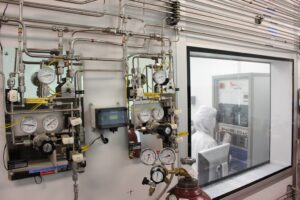Introduction Oxygen Depletion, also known as oxygen deficiency, is a serious safety issue that occurs when the oxygen concentration in an environment falls below the level necessary to sustain human life. The Occupational Safety and Health Administration (OSHA) defines an environment where oxygen levels fall below 19.5% as an oxygen-deficient atmosphere, which should be treated […]
READ MORE
PureAire Monitoring Systems is proud to note the completion of our 26thyear in the Gas Detection business. Our journey began on January 14, 1997, with three employees working out of a spare bedroom in our founder’s home. Our mission from the beginning was, and remains, quite simple: keep people safe, by providing high-quality, accurate, and reliable […]
READ MORE
Lithium-Ion Batteries Rechargeable lithium-ion (“Li-ion”) batteries (comprised of cells in which lithium ions move from a negative electrode through an electrolyte to a positive electrode during discharge—and the other way around when charging) were first described conceptually in the 1970s. Following initial prototype development in the 1980s, li-ion batteries became commercially viable in subsequent decades, […]
READ MORE
MRI Magnetic resonance imaging (MRI) is a diagnostic procedure that uses a combination of a very large magnet, radio waves, and a computer to produce detailed, cross-sectional, and three-dimensional images of organs and structures within the body. An MRI scan is a valuable diagnostic tool that can show injuries or other anomalies that cannot be […]
READ MORE
In March 2018, at two separate fertility clinics, one in Cleveland and the other in San Francisco, the cryogenic tanks storing eggs and embryos malfunctioned, resulting in devastating losses for couples hoping to conceive children. Nationwide, as of December 2019, there were more than 440 sites that store embryos or eggs in specialized storage tanks […]
READ MORE
Inert gases power a wide range of industries, including pharmaceutical, automotive, manufacturing, and semiconductor. While argon, helium, nitrogen, and cryogenic gases have benefits and uses, there are also risks with other gases such as halogens, refrigerants, combustibles, or etching gases. Gas detectors can monitor storage areas and facilities where these gases are used to guard […]
READ MORE
*Click here to read more about product An explosion at a university research lab in Hawaii last year highlights the dangers of working with compressed gas and the need for safety equipment on campus. Learn the dangers of working with compressed gas, how an oxygen deficiency monitor can help, and campus safety best practices. Compressed […]
READ MORE
Neon gas has a range of uses in industry, including in the popular business signs advertising stores as open. Explore some of the less well-known ways to use neon and learn how use of the gas may require installation of an oxygen deficiency monitor to protect worker safety. Uses for Neon Gas Neon gas […]
READ MORE
As users demand ever-smaller smartphones and better televisions, semiconductor manufacturing plants are tasked with developing new products faster and using new materials. Key to the continued success of the semiconductor industry are inert gases, which include nitrogen and argon. When used safely, both nitrogen and argon play a number of important roles within the semiconductor plant. Yet, these gases poses […]
READ MORE










